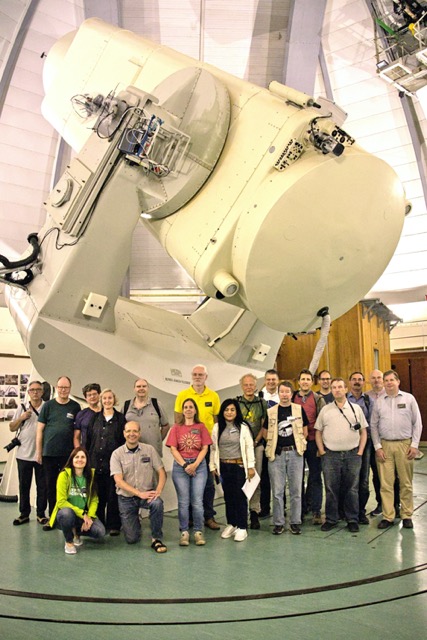The „Small Planets“ group of the association Vereinigung der Sternfreunde e.V. (VdS) visited the Thuringian State Observatory in Tautenburg on May 26, 2024,. The observation of so-called “Near Earth Objects” is a research focus there. We explain what these Near Earth Objects are and why they are observed.
From May 24 to 26, 2024, 35 members of the “Small Planets” section of the Vereinigung der Sternfreunde e.V. met for their annual conference in Jena and Tautenburg. The VdS was founded in 1953 and is – according to their own description – the largest astronomical association in the German-speaking world with around 4,000 members.
 Foto: TLS
Foto: TLS
On Saturday, May 25, the participants listened to presentations in the Senate Hall of the Friedrich Schiller University in Jena. The stargazers discussed observation techniques and methods, the analysis of star occultations by transiting minor planets, measurements with robotic telescopes, how to find new asteroids with amateur equipment and what to do if an object is on a collision course towards Earth.
On Sunday, 26 May, Dr. Bringfried Stecklum, astronomer at the Thuringian State Observatory and coordinator of small planet observations, reported on the history of the Thuringian State Observatory and its many years of experience in tracking down asteroids. He showed the 2-meter Alfred Jensch telescope, other observation facilities such as the LOFAR telescope, the solar laboratory and the plate archive. With the world's largest Schmidt camera, the Alfred Jensch Telescope is the longest-serving telescope in the world in the field of observing minor planets.
What are minor planets?
Our solar system is populated by a vast number of smaller bodies - minor planets or asteroids. Such minor planets are not always just lumps of rock. Their inner structure can be very different. In technical jargon, loosely bound objects are referred to as “rubble piles” or even “flying sand banks”. In most cases, these are former comets whose ice has evaporated during many passes by the sun.
They all have one thing in common: they move in an orbit around the sun. It is important to know the orbit of these minor planets as precisely as possible, as many of them cross the Earth's orbit. And that could be dangerous.
Productive collaboration between amateur and professional astronomers
For some years now, special sky surveys have been carried out to find all Near Earth Objects larger than 100 meters because the orbits of these bodies can change and they could collide with Earth. However, the sky surveys provide so many new objects that their classification and orbit monitoring is only possible with the support of amateur astronomers.
The Minor Planet Center (MPC) currently estimates the total number of discovered minor planets at around 1.3 million (as of May 2024). The Minor Planet Center at the Smithsonian Astrophysical Observatory is the official institution that collects, evaluates and publishes data on minor planets and comets. It operates under the auspices of the International Astronomical Union (IAU).
When professional or amateur astronomers observe minor planets, they send the results of their observations, i.e. the coordinates and brightness of the object at the relevant time, to the Minor Planet Center. Amateur astronomers usually observe brighter objects, while telescopes with a larger diameter, such as the Alfred Jensch Telescope in Tautenburg, select fainter objects.
The Thuringian State Observatory has been involved in the classification and monitoring of Near Earth Objects since 2010. Continuous measurements of the celestial position of newly discovered and known near-Earth asteroids increase the accuracy of their orbits. This makes it easier to assess whether a new object is close to Earth or not, or whether the danger posed by a known asteroid has increased or decreased. With an average of 6,000 measurements per year, the Thuringian State Observatory is now one of the most productive observatories in Europe for this activity.

